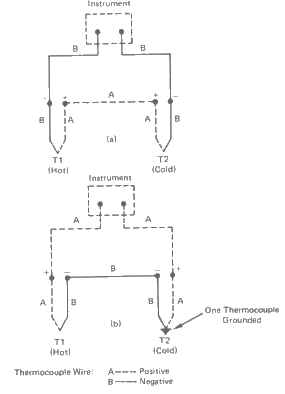|
Thermocouples
are often used for differential temperature (∆T) measurement in
industrial processes where the differential is of a span sufficient
to generate the required signal for the associated instrumentation.
Thermocouples provide a possible advantage over other sensor types where
small size and ease of interchangeability are important.
The
output of a given span is not linear for the common thermocouple calibrations.
When the process requires ∆T measurement over only a restricted
range of working temperatures, the non-linearity may not be significant.
The combined limits of error in degrees for two thermocouples in ∆T
measurement is equal to the square root of the sum of the squares of
the individual thermocouple limits of error. For J and K calibrations,
and standard limits of error for thermocouples below 277oC,
Intermediate connections should be minimized in the ∆T thermocouple
circuit to lessen the introduction of parastic EMF's and the reduction
of accuracy that can result. One, or both, of the thermocouples
should be ungrounded.
When
two thermocouples are connected for ∆T measurement either the
positive or negative legs of the thermocouples are connected together,
with the remaining legs connected to the instrument. There is a reversal
in polarity of the differential temperature signal when the thermocouple
junctions change relationship regarding the "hot" and "cold"
designations. If a zero-centered span is not available on the
associated instrument, then provisions must be made to reverse polarity
at the instrument. Reference junction compensating is not utilized
for the individual thermocouples when they are connected for ∆T
measurement.
|
A
∆T measurement is not absolute and, as such, will not give an
indication of undesirable over-temperature condition in a process, location
of the sensors, and installation details.
REFERENCE: R. B. Crawford "Industrial Applications of Temperature
Difference Measurements", Temperature, Its Measurement and Control
in Science and Industry (Remhold Publishing Corporation, New York, 1962.
Volume 3, Part 2, PP.913-925
Schematic Wiring for ∆T with Thermocouples.

|

